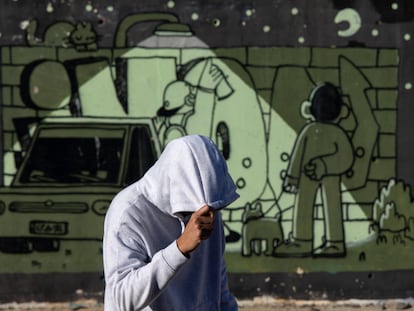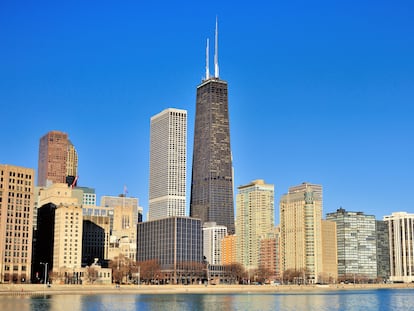Artists fight to keep the neon lights on in Hong Kong
Technological advancements and new regulations had led to buildings losing their trademark illuminations, leaving the city into the dark. Faced with a dwindling number of neon masters, there is a growing number of emergent creatives studying the craft and sharing their skills
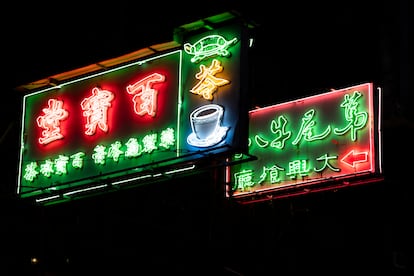
The defeat of China in the opium wars of the 19th century left the island of Hong Kong, including the Kowloon peninsula, the New Territories and the Outer Islands, under British colonial rule. So it remained until the night of June 30, 1997, when Hong Kong began a transition towards complete reintegration with China by 2047. Until then, it is classified as a special administrative region of the Asian world power, a halfway step that has left its residents wondering about the future. They ponder just what their relationship with China will look like. Their uneasiness is justified.
In the decades that followed the handover, rights have been curtailed, the press limited and the people banned from demonstrating against various injustices. This dismantling has not been limited to political and social areas; it also applies to culture and memory. Tightening government regulations regarding the environment, light pollution, sizing, and safety measures have all led to one of Hong Kong’s local trademarks being extinguished: its famed neon signs.
The illuminating designs were largely concentrated in the Hong Kong of the collective imagination, which like a movie set comprised a relatively small area. In the majority of the neighborhoods where Hong Kongers live, largely in towers that rise like beehives, there have never been neon signs. Nor have they ever been present in the border area it shares with China, the New Territories, nor on the densely populated island of Ap Lei Chau. But the few neon signs that remain in their traditional haunts shine with injured glory, some looking better than others. The companies and people who manufacture and repair them have undergone a similar fate. With so few neons left, an entire industry and body of knowledge is switching off. Few neon masters — si fu, as they are referred to in Cantonese, the Chinese dialect spoken in Hong Kong — remain, like the octogenarian Mr. Wong and Wu Chi Kai, who is approaching his 60th birthday. They are reputable artisans of their trade, but balk at sharing their knowledge with strangers.
But despite the dwindling number of masters, there is a growing community of Hong Kong artists who study, work and create with neon and other noble gases. Two can be found in Karen Chan (36), better known as Chankalun, whose project is called The Neon Girl, and Jive Lau (41), who in 2020 founded Kowloneon, a studio in which he creates and teaches the art of bending neon glass tubes.
In addition to exploring the possibilities of glass and gas as a form of modern art, both teach others the knowledge they have gained. It’s a way to ensure the future of neon culture. Both are advocates for their craft, which suffered after the emergence of a cheaper, more energy-efficient, more easily maintained light source: the LED. The competitive relationship between the two serve as a metaphor that explains the fate of Hong Kong. Imagine what films like The Day of the Beast, Blade Runner or anything from local director Wong Kar-wai would have been like, had the neon signs that appear as backdrop been substituted by LEDs.
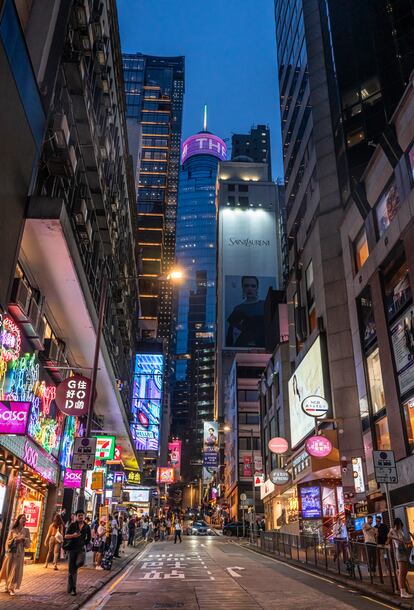
As of the 1950s, Hong Kong’s neon signs have been very useful visual references for the area’s visitors as well as marketing tools for businesses — and indirectly, for their manufacturers. At the same time skyscrapers were being erected in Hong Kong, marking its rise as a world financial center, neon signs were being hung on the facades of buildings to advertise pawnshops, bakeries, saunas, restaurants, teahouses, coffeeshops, rent-by-the-hour love hotels, Chinese medicine stores and mahjong parlors, where visitors play the popular Chinese board game. Signs made the area’s nocturnal hours fluorescent, electric. But how do they work? Neon lights are comprised of a sealed glass tube that contains a small amount of gas and air. When connected to a high-voltage power supply, the lamp lights up and the atoms of the neon or other noble gas start to move. The color of its light depends on the kind of gas: red is created by neon, yellow by helium, white by carbon dioxide, and blue by mercury.
The less and less brilliantly colored neons of different sizes and shapes (square, rectangular, bats, leaves, palm trees, shrimps, sunglasses and Chinese characters abound) that remain can mainly be seen on Nathan Road, Portland, and Shanghai Street, on the Kowloon peninsula, and on Lockhart Street and Johnston Road in Wan Chai on Hong Kong island. Located on land that has been reclaimed from Victoria Harbor on the Kowloon peninsula is the M+, a museum of contemporary audiovisual culture that features a collection of drawings of neon designs, as well as some well-known signs, including an Angus cow from a steak restaurant. The museum has even done some crowdsourcing, asking the public to weigh in on the creation of a map to the surviving neon signs in the area that speak to a vanishing era.
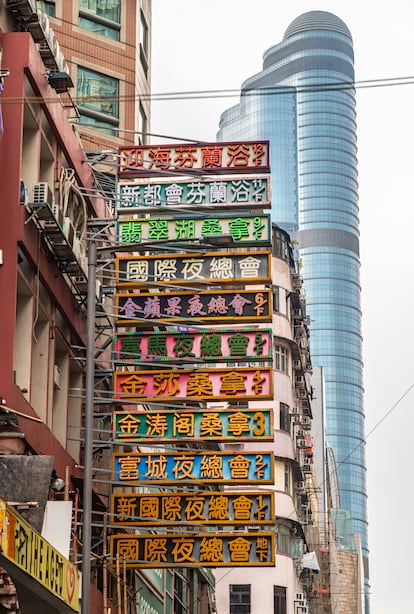
In Central’s tourist and nightlife zone of Lan Kwai Fong, a sloping street lined with bars and restaurants, a newborn neon sign hangs that was created by the aforementioned Lau, who also runs the G.O.D. store. The artist, who has design training in various specialties, arranged a meeting with EL PAÍS via Instagram at Kwun Tong Studio, on the south side of Hong Kong island, located on the other side of the mountain and on the outskirts of the busy downtown. His studio is on the seventh floor of a building that is home to several other similar workspaces funded by the government. It appears that the administration that is cutting back on rights and freedoms also believes that neon culture is worth preserving.
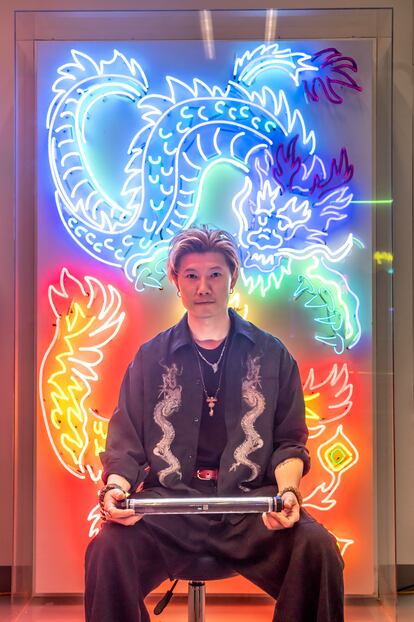
Lau speaks softly, smoothly. His youthful appearance belies his age. He is dressed in in a black shirt and a wide pair of pants with two big front pockets, their monochrome making his bleached-blonde hair pop. Around his neck he wears various pendants, with bracelets on his wrists and no lack of rings on his fingers. The studio is clean and orderly. There are various worktables and chairs, in addition to a small library with books on design and neon. On the walls hang his own neons — a panda bear, a dragon facing off with an eagle — and the tools he uses to work. He’s available for commissions from clients he meets through word of mouth and social media, where he posts videos and photos of his process and final products. The space is enveloped in noise when he turns on a narrow, elongated device from which a bluish flame soon appears. When it reaches 1,832 degrees Fahrenheit, he picks up a glass tube. As he puts it into contact with the flame, he blows air from his mouth through a rubber band attached to the other end of the tube, into which gas (neon, argon, helium, carbon dioxide, mercury) has also been injected. And so, coupling fire and air with precision and delicacy, he molds a glass tube that, with the heat, has become flexible. It is an art that requires knowledge of both chemistry and engineering.
As he carries out the demonstration he speaks of how he learned the art of neon in Taiwan, where masters are more open to sharing their knowledge. Lau has also turned to internet tutorials. He’s conscious of the fact that neon has an expiration date, but also that it’s a Hong Kong trademark that he’d like to keep alive, somehow. His goal is to create artisanal pieces that shine in the street, rather than in a gallery. Neons beneath which Hong Kongers will meet each other, exchange fleeting glances, even collide when they aren’t paying attention. Neons are both their own history and witness to those of others. Even when they are turned off.
Travel diary
Walking is the best way to get to the streets in which the few remaining neon signs hang from building facades. These illuminated thoroughfares include Nathan Road, Portland, and Shanghai Street, all three located on Hong Kong peninsula, and Lockhart Street and Johnston Road in Wan Chai (on Hong Kong island), very close to Aki MGallery, a luxurious, minimalist Japanese-inspired hotel. Finding where to eat is not difficult — there are restaurants everywhere you look, it’s just a matter of choosing one.
Tetra Neon Exchange is a group dedicated to the conservation of signs in disuse that organizes walks to see surviving historic neon signs in Hong Kong. Another similar project is The Hong Kong Neon Heritage, which looks to raise awareness about the disappearing signs.
To understand the city-state and get to know a bit more about its neons, read Hong Kong Neon by Swiss photographer Pascal Greco and see the movies Chinese Box, directed by Wayne Wang and starring Gong Li and Jeremy Irons, and A Light Never Goes Out by filmmaker Anastasia Tsang, about a family dealing with the death of a neon sign maker.
Sign up for our weekly newsletter to get more English-language news coverage from EL PAÍS USA Edition
Tu suscripción se está usando en otro dispositivo
¿Quieres añadir otro usuario a tu suscripción?
Si continúas leyendo en este dispositivo, no se podrá leer en el otro.
FlechaTu suscripción se está usando en otro dispositivo y solo puedes acceder a EL PAÍS desde un dispositivo a la vez.
Si quieres compartir tu cuenta, cambia tu suscripción a la modalidad Premium, así podrás añadir otro usuario. Cada uno accederá con su propia cuenta de email, lo que os permitirá personalizar vuestra experiencia en EL PAÍS.
¿Tienes una suscripción de empresa? Accede aquí para contratar más cuentas.
En el caso de no saber quién está usando tu cuenta, te recomendamos cambiar tu contraseña aquí.
Si decides continuar compartiendo tu cuenta, este mensaje se mostrará en tu dispositivo y en el de la otra persona que está usando tu cuenta de forma indefinida, afectando a tu experiencia de lectura. Puedes consultar aquí los términos y condiciones de la suscripción digital.
More information
Archived In
Últimas noticias
Welcome to the post-religion era: The idea of Christianity as the absolute truth has become obsolete
‘I thought you would like it’: The risky sexual practice popularized by TV shows and TikTok
The digitalization of tourism: ‘They promise experiences and gave us the worst possible one’
Mexican peso defies uncertainty with forecasts of a new period of stability in 2026
Most viewed
- Sinaloa Cartel war is taking its toll on Los Chapitos
- Reinhard Genzel, Nobel laureate in physics: ‘One-minute videos will never give you the truth’
- Oona Chaplin: ‘I told James Cameron that I was living in a treehouse and starting a permaculture project with a friend’
- Why the price of coffee has skyrocketed: from Brazilian plantations to specialty coffee houses
- Silver prices are going crazy: This is what’s fueling the rally
